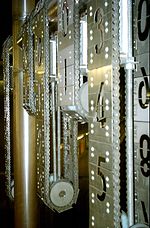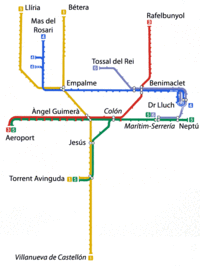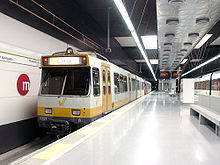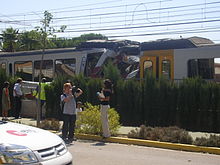- Metrovalencia
-
For other uses, see Valencia Metro (disambiguation).
Metrovalencia 
Info Owner Ferrocarrils de la Generalitat Valenciana Locale Valencia, Spain Transit type Metro
TramNumber of lines 5 Number of stations 169 Chief executive Mario Flores Lanuza Operation Began operation October 8, 1988 (as FGV)
May 5, 1995 (as MetroValencia)Number of vehicles 82 Technical Track gauge 1,000 mm (3.3 ft) Electrification 750 V DC
1500 V DC, overhead wireMap of Metrovalencia Metrovalencia (Valencian: [ˌmetɾovaˈlensia], Spanish: [ˌmetɾoβaˈlenθia]) is a modern amalgamation of former FEVE narrow gauge diesel and electric operated suburban/regional railways. It is a large suburban network that crosses the city of Valencia, with all trains continuing out to far-flung suburbs. It also has destinations on lines that make it more closely resemble commuter trains. The unique system combines light railway, metro and several tram operations north of the Túria riverbed park with line 4. Tram line 6 and the short extension of metro line 5 are operated by modern trams.[1]
This network consists of more than 134 kilometres (83 mi) of track, of which around 19 kilometres (12 mi) is below ground.
The system authority Ferrocarrils de la Generalitat Valenciana uses bilingual signage in Valencian and Spanish.
Contents
Lines
Technical data
- Gauge width: 1000 mm
- Current system: 750 V DC / 1500 V DC, overhead wire
History
 Many stations have an artistic exhibit in the entrance hall. This one is in Benimaclet.
Many stations have an artistic exhibit in the entrance hall. This one is in Benimaclet.
First four lines
On 8 October 1988 the tunnel through which line 1 crosses Valencia was opened between Sant Isidre and Ademuz (now Empalme), which connected the line with southbound trains from València-Jesús to Castelló de la Ribera (now Villanueva de Castellón) at Sant Isidre. Line 2 went from València-Sud to Llíria, with some trains terminating in Paterna.
In May 1994 the tranvia line 4 opened. Valencia was the first city in Spain to use this mode of transport in modern era. Originally line 4 was 9.7 kilometres (6.0 mi) long and had 21 stations. The line connected the suburban lines with high demand zones such as the Polytechnic University, the new university campus and the Malvarosa beach, which the former line Empalme - Pont de Fusta - El Grau had connected before. One year later, in May 1995, line 3 was extended from El Palmaret in Alboraria to Alameda. The extension reused the older railway line Pont de Fusta-Rafelbunyol, of which part was scrapped (between Pont de Fusta - Sant Llorenç - El Palmaret), and the rest was switched from 750 V to 1500 V.
Further alterations followed five years later. On 16 September 1998, line 2 was merged with line 1, and Line 3 was extended from Alameda to Avinguda del Cid in the west and Torrent in the south with some trains only going as far as Jesús. Half a year later, on 20 May 1999, line 3 was extended from Avinguda del Cid to Mislata-Almassil
Lines 5 and 6, and more extensions
In April 2003, the new line 5 was opened. This line took over the previous line 3 connection from Alameda to Torrent, together with a newly constructed branch from Alameda to Ayora 2.3 kilometres (1.4 mi). (Although some very early morning trains still travel from Machado to Torrent, this is not represented on maps.) One year later, the new line 5 was extended, together with line 1, from Torrent to Torrent Avinguda, a distance of 2.3 kilometres. On October 3, 2005, Bailén station was opened on line 5. This station is between Colón and Jesús, and has connections with València-Nord, the main railway station of València. Furthermore, Bailen is close to the Plaça d'Espanya station on line 1. In October 2005, line 4 was extended to Mas del Rosari, and on 20 December 2005 to Lloma Llarga-Terramelar.
On 2 April 2007, Line 5 was extended to the East to a new station Marítim-Serrería (originally planned as Jerónimo Monsoriu).
On 18 April 2007, Line 5 extended to the Airport (Aeroport Station) in the west and to the Port (Neptú Station) in the east, this last section from Marítim-Serreria to Neptú is a tram section; the trains go from Aeroport to Marítim-Serrreria and then a tram operates between Marítim-Serreria and Neptú. Line 3 was extended to the Airport as well to cover the schedule limitations of line 5 to Aeroport station.
On 22 September 2007, Line 6 was opened, linking the neighbourhoods of Orriols and Torrefiel to the metro system for the first time. Additionally a new station "Torre del Virrei" was added to Line 1. It is situated between the stations of "L'Eliana" and "La Pobla de Vallbona".
On 12 December 2010, the two overground line 4 stations in the municipality of Alboraya, Alboraya and Palmaret, were replaced by the subterranean stations of Alboraya - Peris Aragó and Alboraya - Palmaret. On Line 1, the station of Jesus was renamed Joaquin Sorolla, while the Hospital station was renamed Safranar.
Future lines
Four more lines are planned to be inaugurated in upcoming years. Line 2 is under construction, and its inauguration is expected to be in 2011. Line 7, without new stations, will be inaugurated in 2011. It will be a new connection with stations from lines 3, 4, 5, 6 and a future eighth line.
Accidents
On 9 September 2005, two trains crashed into each other on Line 1. Nobody was killed, but according to early reports 35 people were injured, 4 of whom were taken to hospital, their condition described as serious. The first train had been stationary waiting for a red signal. The second used its emergency brakes to avoid a collision, but was hit by a third train. The force of the impact severely damaged the drivers' cabs at the front of the last train and at the rear of the second train. The crash occurred between Paiporta and Picanya about 5 km south-east of the city centre. The 3729 and 3730 EMUs are now a single EMU with 3729A and the 3730A cars, the 'B' cars were severely damaged and are currently at València-Sud workshop, waiting to be scrapped.
3 July 2006 was a black day for the Valencia metro. In a severe accident, a two-car EMU derailed between Jesús and Plaça d'Espanya stations. At least 43 people were killed and 52 injured. It was the worst metro accident in Spanish history.
See also
References
- ^ Conversion Of Railway Lines For Suburban Passenger Services - Accessed 07/05/2011
External links
 Media related to Metrovalencia at Wikimedia Commons
Media related to Metrovalencia at Wikimedia CommonsRail transport in Spain Operators AVE · RENFE · FEVE · EuskoTren · Ferrocarril de Sóller · Serveis Ferroviaris de Mallorca · Ferrocarrils de la Generalitat Valenciana · Ferrocarrils de la Generalitat de Catalunya · Acciona · COMSA Rail TransportCommuter lines Metro/Light rail Alicante · Barcelona Metro · Barcelona Tram · Bilbao Metro · Bilbao Tram · Madrid · Valencia · Málaga · Granada · Jaén · Vitoria-Gasteiz · Palma de Mallorca · Seville · Tenerife · Parla · Vélez-Málaga · Zaragoza TramCategories:- Valencia, Spain
- Transport in the Valencian Community
- Rail transport in the Valencian Community
- Rail transport in Spain
- Underground rapid transit in Spain
- Rapid transit in Spain
Wikimedia Foundation. 2010.



